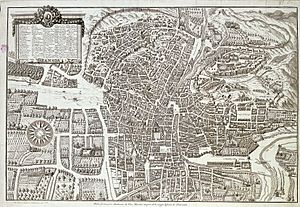Luis del Mármol Carvajal facts for kids
Luis del Mármol Carvajal (born in Granada, Spain, around 1524 – died in Vélez-Málaga, Spain, around 1600) was an important Spanish historian. He spent many years living among the Morisco people in the former Granada kingdom. Moriscos were Muslims in Spain who were forced to convert to Christianity. He also traveled in North Africa among the Berber people.
Contents
Early Life and Travels
Luis del Mármol Carvajal was born in Granada, Spain. His father, Pedro del Mármol, was a scribe for the High Court of Granada. Luis's father officially recognized him as his son in 1528. His family was likely Christian, though not from a noble background.
When he was about 12 years old, Luis began traveling by sea. This early experience helped him learn different languages. He became skilled in Arabic and various Berber languages.
Adventures and Captivity
In 1535, Luis del Mármol Carvajal joined Emperor Charles V on a trip to Tunis. Around 1545, he was captured by the Turks. He was taken as a slave to Africa and the Middle East, traveling as far as Guinea.
He remained a captive for seven years and eight months. During this time, he greatly improved his knowledge of Arabic and Berber languages. In 1554, a religious group helped him gain his freedom. However, he chose to stay in Africa to explore and study the continent. He even traveled to Egypt and Ethiopia.
Return to Spain and His Writings
In 1557, Luis del Mármol Carvajal returned to Spain. He then fought in Italy as part of the army of the Duke of Alba. In 1571, he settled near the city of Vélez-Málaga. Here, he began writing his famous work about Africa.
His first major book was called Descripción general de África (General Description of Africa). In 1579, he hoped to become the Spanish ambassador to Morocco. However, King Philip II of Spain chose someone else. This was because the other person had a more noble background, even if Mármol was more skilled.
In 1599, he published the second part of his Descripción general de África. His final work, called Rebelión, was published in 1600. In this book, Mármol shared his ideas about history. These ideas were influenced by the Classicism and Renaissance Humanism movements.
Historical Importance
Luis del Mármol Carvajal's historical writings are very important. His work covers a longer period of time than that of another famous African chronicler, Leo Africanus. Leo Africanus was also known as Joannes Leo Africanus. Mármol's detailed accounts give us valuable information about the 16th century.
See also
 In Spanish: Luis del Mármol Carvajal para niños
In Spanish: Luis del Mármol Carvajal para niños


